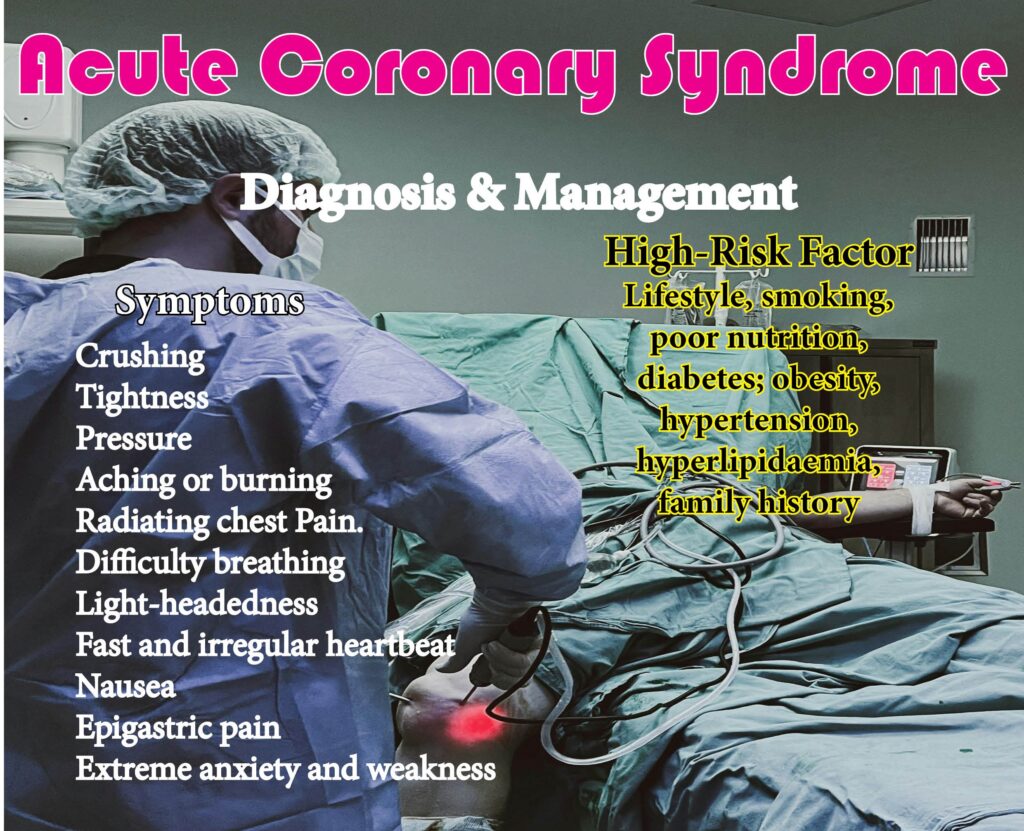Acute coronary syndrome (ACS) and Coronary heart disease and remain predominant and the leading cause of death in individuals over the age of 35 years.


ACS encompasses a group of diseases characterized by a sudden reduction in blood flow to the heart, including ST-elevation myocardial infarction (STEMI), non-ST elevation myocardial infarction (NSTEMI), and unstable angina (UA). These conditions typically result from the narrowing and disruption of coronary arteries due to atherosclerosis. The rupture of an atherosclerotic plaque can lead to partial or complete artery blockage, resulting in diminished oxygen supply to the heart muscles, which can manifest as angina or myocardial infarction (heart attack).
ACS is associated with high morbidity and mortality and can be caused by various mechanisms, including plaque rupture with inflammation, plaque rupture without inflammation leading to fibrin-rich red thrombi formation, plaque erosion resulting in non-ST-segment–elevation myocardial infarction, and ACS without thrombus affecting both epicardial arteries and coronary microcirculation.
Modern lifestyle factors such as smoking, poor nutrition, increased incidence of diabetes, obesity, hypertension, and hyperlipidemia contribute to the high rates of ACS. Additionally, a family history of coronary artery disease is a significant risk factor.
Common symptoms of ACS include substernal chest pain, radiating to the shoulders, arms, upper abdomen, back, neck, and jaw, although other symptoms such as difficulty breathing, lightheadedness, rapid or irregular heartbeat, nausea, epigastric pain, extreme anxiety, and weakness may also be present.
Diagnostic tools such as electrocardiogram (ECG), echocardiogram, coronary angiogram, computed tomography angiography (CTA), myocardial perfusion imaging (MPI), and blood tests are utilized to aid in the diagnosis of ACS. Maintaining a high degree of suspicion and vigilance is crucial during the diagnostic process.
Treatment of ACS depends on the type (STEMI/NSTEMI or unstable angina) and requires timely intervention. An inter-professional team comprising emergency department physicians, cardiologists, internists, pharmacists, and primary caregivers is essential for optimal management. Public awareness and recognition of symptoms are also vital in ensuring timely treatment.
Furthermore, public education regarding lifestyle modifications, including smoking cessation, maintaining a healthy weight, regular exercise, and adopting a healthy diet, plays a crucial role in controlling the high mortality associated with ACS. These preventive measures contribute significantly to mitigating the impact of this disease.


Dr Mahantesh R. Charantimath
Senior Consultant Interventional
Cardiologist,
Tathagat Heart Care centre,
32/60, 2nd main Vyalikaval,
Next to Canara bank, Bangalore 03
Ph 080-23462515 Mb: 94484 62883
http://tathagathearthospital.com/











